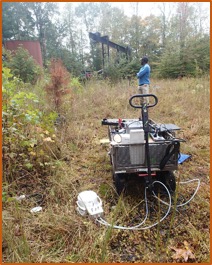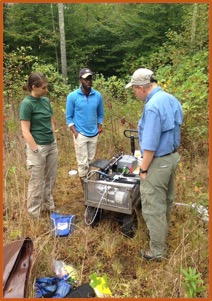Home » Discovery Grants » Methane Rising: A brief description of how we measured escaped methane at hydraulically fractured gas wells
Methane Rising: A brief description of how we measured escaped methane at hydraulically fractured gas wells
Posted by anderc8 on Wednesday, January 11, 2017 in Discovery Grants, News.

This is our general equipment set up. The white instrument is our air tight chamber that is connected to our CRDS instrument located in the wagon. The system is powered by a deep cycle marine battery and is connected wirelessly to a tablet that allows to view the data in real time. In the distance is the well head of the “leaky” well. (Photo Credit: Prof. J. Ayers)
Written by Vanderbilt Ph.D. student Moyo Ajayi
During the beginning of the 21st century, oil and gas producers have tapped into previously uneconomical sources of natural gas using the controversial method of high volume hydraulic fracturing (HVHF). HVHF involves injecting highly-pressurized fluid into impermeable rocks to fracture them and release natural gas. Use of HVHF in the United States has greatly increased gas production and lowered cost, but it may be causing incidental releases of the powerful greenhouse gas methane. Methane is the primary component of the natural gas; however, it is the second most prevalent greenhouse gas (on the basis of concentration) in the atmosphere and also has a global warming potential that is 25 times greater than carbon dioxide. My research project aims to answer the question: does HVHF activity and natural gas production cause methane leakage to the atmosphere?
My research, conducted in eastern Tennessee with Vanderbilt professors John Ayers and George Hornberger and collaborators from the University of Tennessee (UT), seeks to answer this question by 1) measuring the quantity of methane being emitted from the soil at HVHF sites and 2) identifying the source of the methane by measuring its carbon isotope composition.
To make these measurements at HVHF sites, we required a device that could accurately and precisely measure the concentration and carbon isotope composition of trace amounts of methane in soil gas. Traditionally, researchers measure the methane “leakage” rate by placing an air tight chamber on the soil surface, periodically withdrawing gas samples using a syringe, and later analyzing the gas samples using a stationary laboratory-based instrument such as a gas chromatograph-mass spectrometer (GC-MS). However, for a variety of scientific and logistical reasons, researchers would prefer to make these measurements in situ, in real time. Fortunately, with the introduction of cavity ring-down spectroscopy (CRDS), researchers can now make measurements when and where they please.

Candid shot taken of us (right to left: Julie McKnight (UT), me, and Prof. Ayers) discussing our next move while observing the data from an ongoing measurement. Each measurement takes at least 40 minutes, excluding set up and break down time. (Photo Credit: Marie English (UT))
Thanks to funding provided by Vanderbilt’s Discovery Grant program, our research group was able to purchase a CRDS instrument (Picarro G2201-i) and an automated chamber (Eosense eosAC) for our research. As part of my MS research (Aug 2014 – Aug 2016), we developed a new method for making precise in situ measurements of both the concentration and carbon isotopic composition of methane in soil gas by connecting a chamber to a CRDS instrument (see photo). Because of our sensitive and careful measurements, we were able to show that one of our four HVHF sites had elevated (above normal background) soil gas and atmospheric concentrations of methane. Equally important, its carbon isotopic composition indicated that the methane originated from a deep source, suggesting that the gas well is leaking. While the well seems to be leaking methane into the soil at a low rate, the methane is leaving the soil and making its way into the atmosphere, where it ultimately can contribute to climate warming.
Our research continues to advance as I have now entered the second semester of my PhD. We plan to continue making measurements in eastern Tennessee (see photo). Also, I am planning to expand the scope of the project to include other locations (e.g. Susquehanna Co., PA in collaboration with researchers from Yale University) and to measure another important greenhouse gas, carbon dioxide. This would help us gain further insights into the origin of atmospheric greenhouse gases.
I hope that at the cessation of my PhD studies, we will have even more discoveries to report and more products to share. Again, a big thank you to the Vanderbilt Discovery Grant program for the funding of our research and novel instrumentation.
One Comment on “Methane Rising: A brief description of how we measured escaped methane at hydraulically fractured gas wells”
Des on May 8th, 2017 at 7:04 am
Interesting project. Great we can now use picaro to measure isotopes in situ. I’m interested to know cost of the field set up, if you don’t mind sharing.
Des
